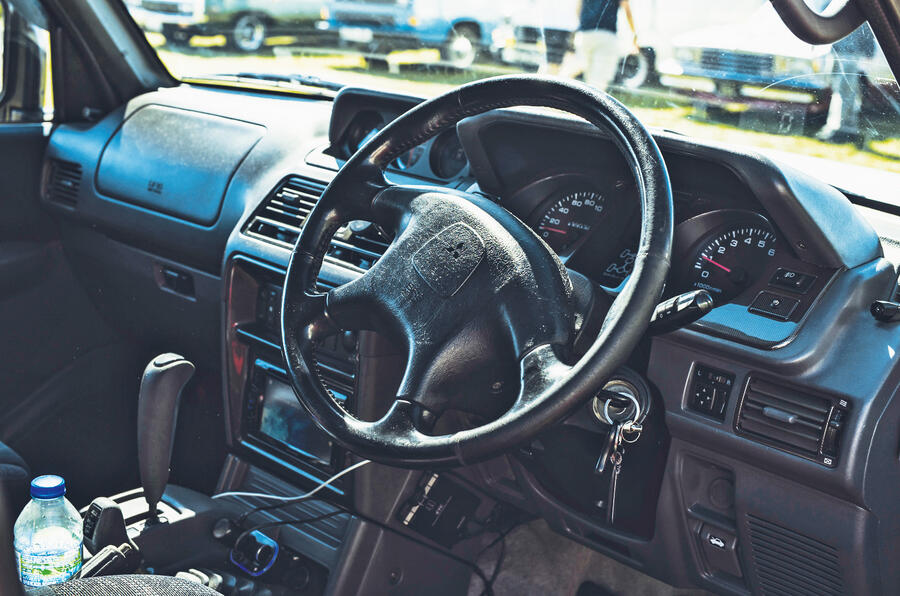Say 'Evo' and the Mitsubishi Lancer Evolution in its many generations springs to mind. At least that's what popped into the head of one UK dealer importing Subaru Imprezas from Japan.
Pat Tennant, who bought an Evo from him, recalls what happened next: "The dealer's supplier told him he had space for two more cars in the shipping container, and would he like a couple of Evos? The dealer thought he meant Lancers and said 'yes please', but when he opened the container at the UK port and saw they were Mitsubishi Pajero Evos, he wondered what they were and how he was going to sell them!"
The dealer had no choice but to advertise the cars. Luckily for him, Pat saw the ad and did some research. "It turned out the Pajero Evo was a very special car," he says. "Mitsubishi wanted to enter the Dakar Rally so built around 2500 road-legal versions, based on the Mk2 Pajero, to qualify.

Apart from having no roll cage, they're technically and visually very similar to the rally cars, with a widened chassis and large, flared wheel arches, multi-link rear suspension, Torsen diffs and a 3.5-litre 24-valve V6 Mivec petrol engine producing 275bhp."
The road-going Pajero Evo was sold for only one year, 1998, but that was enough to give the rally version the green light for the T2 class in the Dakar, which it won. In fact, between 1985 and 2007, Pajeros won a record 12 editions of the rally.
With all this in mind, when the dealer invited Pat to look at these two weird Evos that had just landed, Pat knew he was going to buy one. The only question was which. "I wanted one as close to the factory spec as possible," he says.
"The white one had too much aftermarket kit on it, so it had to be the silver one, which, apart from having an aftermarket exhaust, was totally standard and in lovely condition. With 120,000 miles on it, it cost me £10,000, but I reckon that one day it will be worth £100,000.






Join the debate
Add your comment
I found this site really helpful for car reviews! Check it out and compare details using their calculator 電卓.
Check out this site for informative car reviews and news, and don't forget to relax with a fun game at スイカゲーム!
This was a fantastic car. Mitsubishi excelled themselves...and went quickly downhill after it! The Shogun was a great size for a small SUV (maybe the boot was too small). I had one for 10 years, and all it did wrong was a seized front disc brake and a poorly-performing water pump - both easily fixed. I still have the original Shogun showroom book. If Mercedes is clever, then their new Baby G is going to be the Shogun reborn.
It was such a shame that Mitsubishi lost the plot. The Shogun really was a gem - a much-under-rated small car that will eventually be in the 'hall of fame' along with the Mini, the Defender, and the Beetle.
Must be referring the short-wheelbase variant. Never driven that variant -- only the long-wheel-base one. And that didn't feel so tiny. It however drove OK-ish for a deticated off-roader. At the time, the only comparable vehicle in existence with near similar comfort -- was, 1st. Gen Range-Rove, which then still was in production. Anything else was way more agricultural in feel and manners.
Yes, the SWB. The boot was tiny, but it was the ONLY mark against the Shogun. It really was a fantastic car, and the only car I ever had (out of over 50) which I kept for 10 years. I see from today's news that Mitsubishi is making a comeback in the UK. I really don't know why they lost the plot after the Shogun. The later one looked a bit weird, and they rocketed in price. I had a 2-door Range Rover Vogue, as well, which was as good as the Shogun, though a bit reluctant to shift (it had the 3.5/3.9 V8 petrol). My Shogun was the V6 petrol, and was very nimble. I know what you mean about agricultural - the Daihatsu was just that.
Never drove the short-wheelbase variant, but the long-one had greater comfort and better road manners than any other dedicated off-roader around, bar 1st. gen Range-Rove still then in production. And it didn't feel so small -- but I saw number of the short-wheelbase ones around.
Eggy Car is a fun and engaging game that tests your ability to move a fragile egg over rough terrain. Does that sound easy? Right now, play eggy car!
Play the eggy car game online. You drive a car with a fragile egg passenger, gather coins and power-ups, and drive over difficult slopes without breaking them.